Ware sicher verpackt und schnell verschickt. Alles bestens!
Se oversættelseOldtidens Egypten Bronze Bevinget gudinde Isis. Sen periode, 664 - 341 f.Kr. 12 cm højde. Spansk eksportlicens.
Nr. 90344467
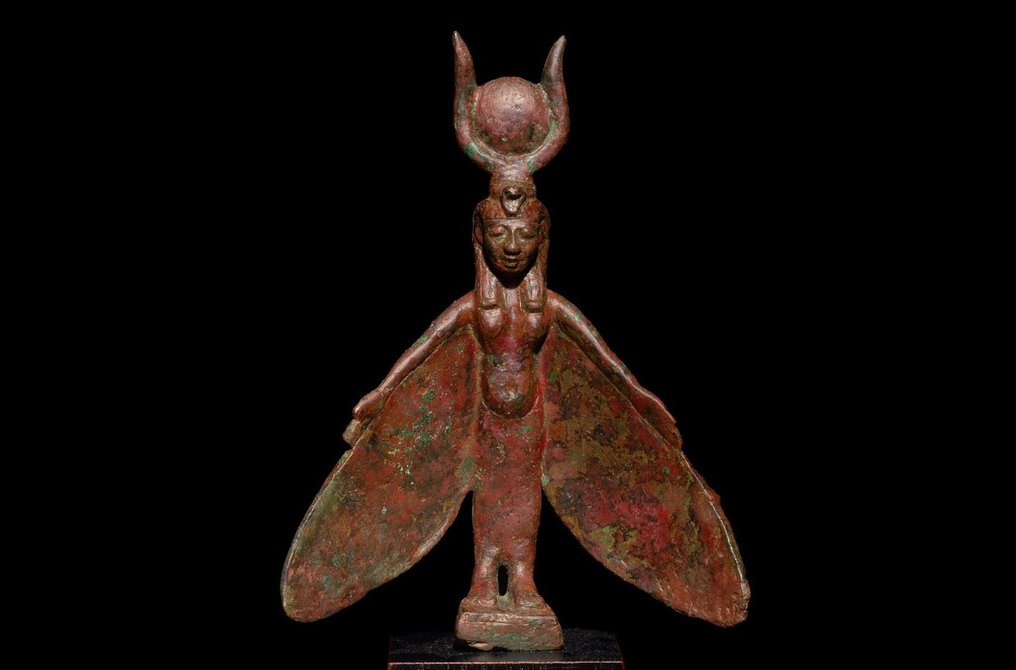
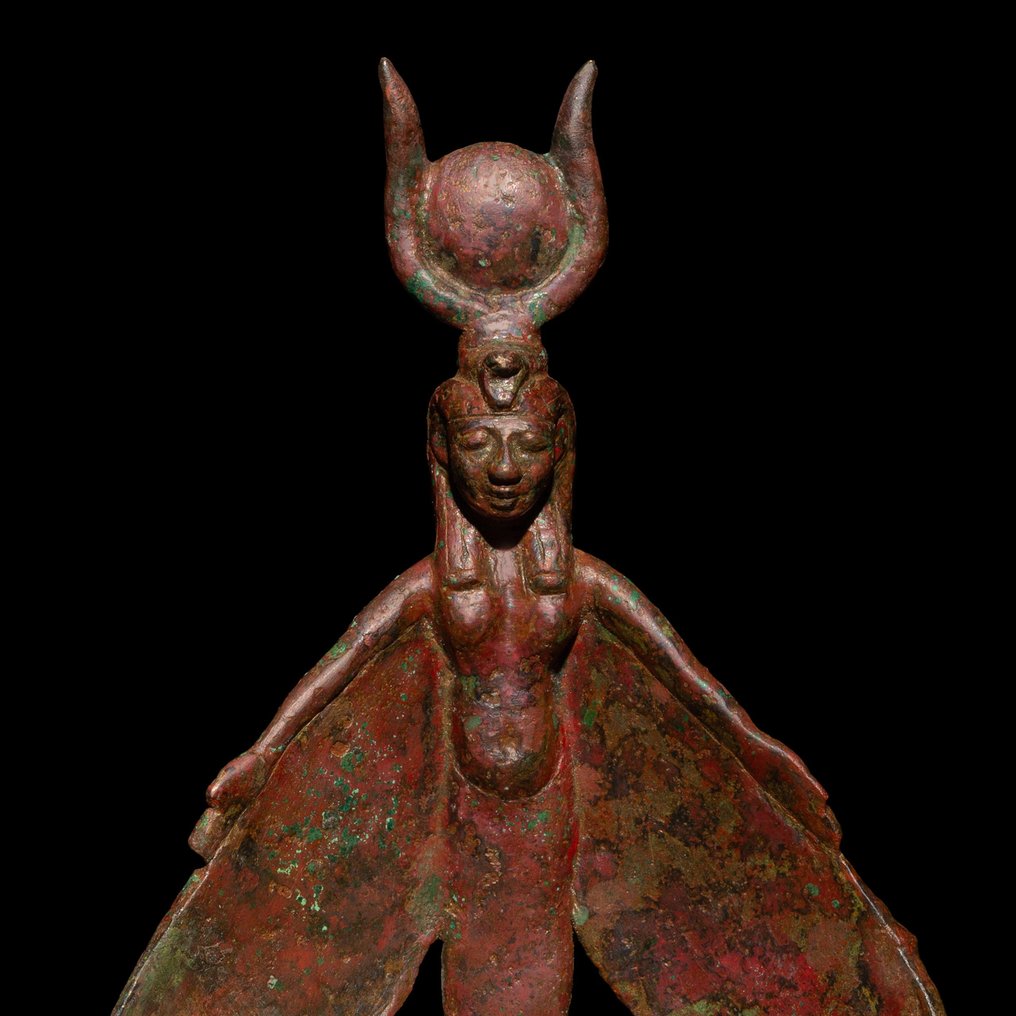
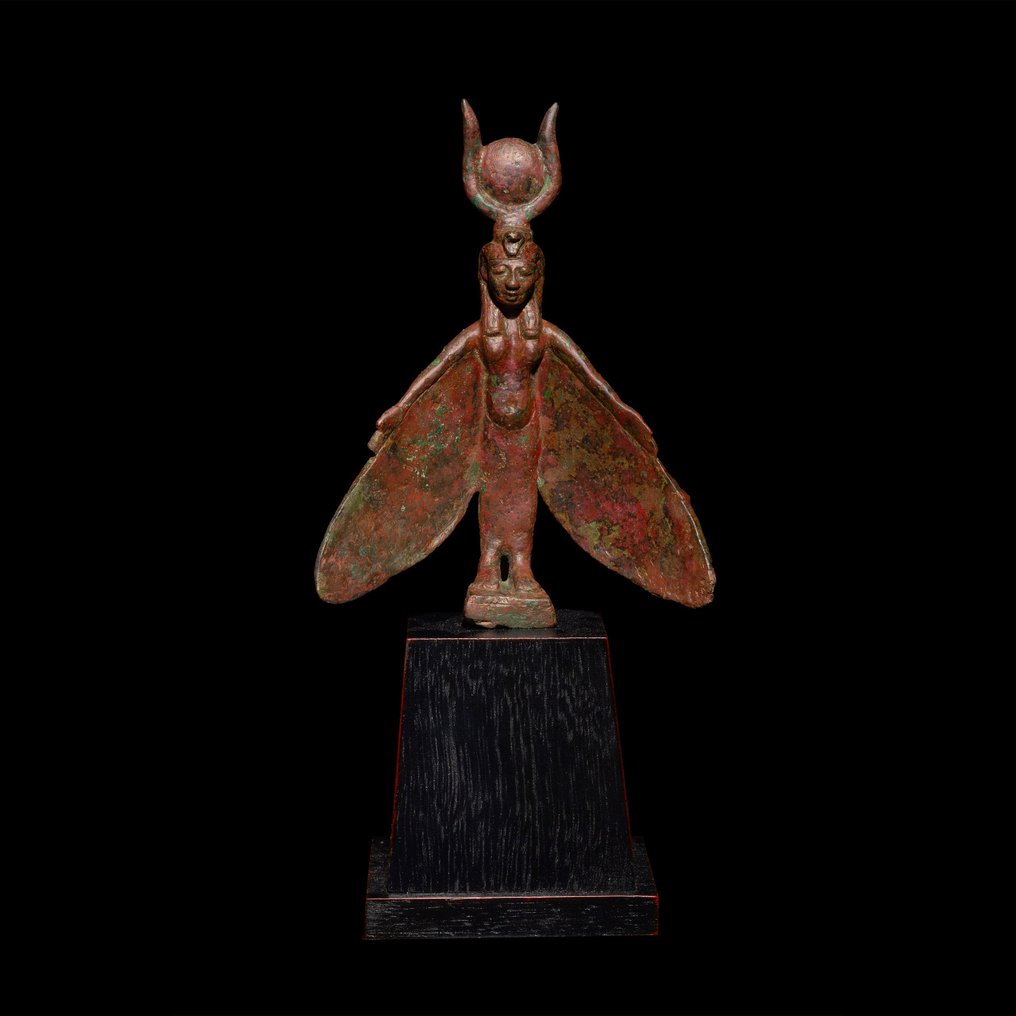

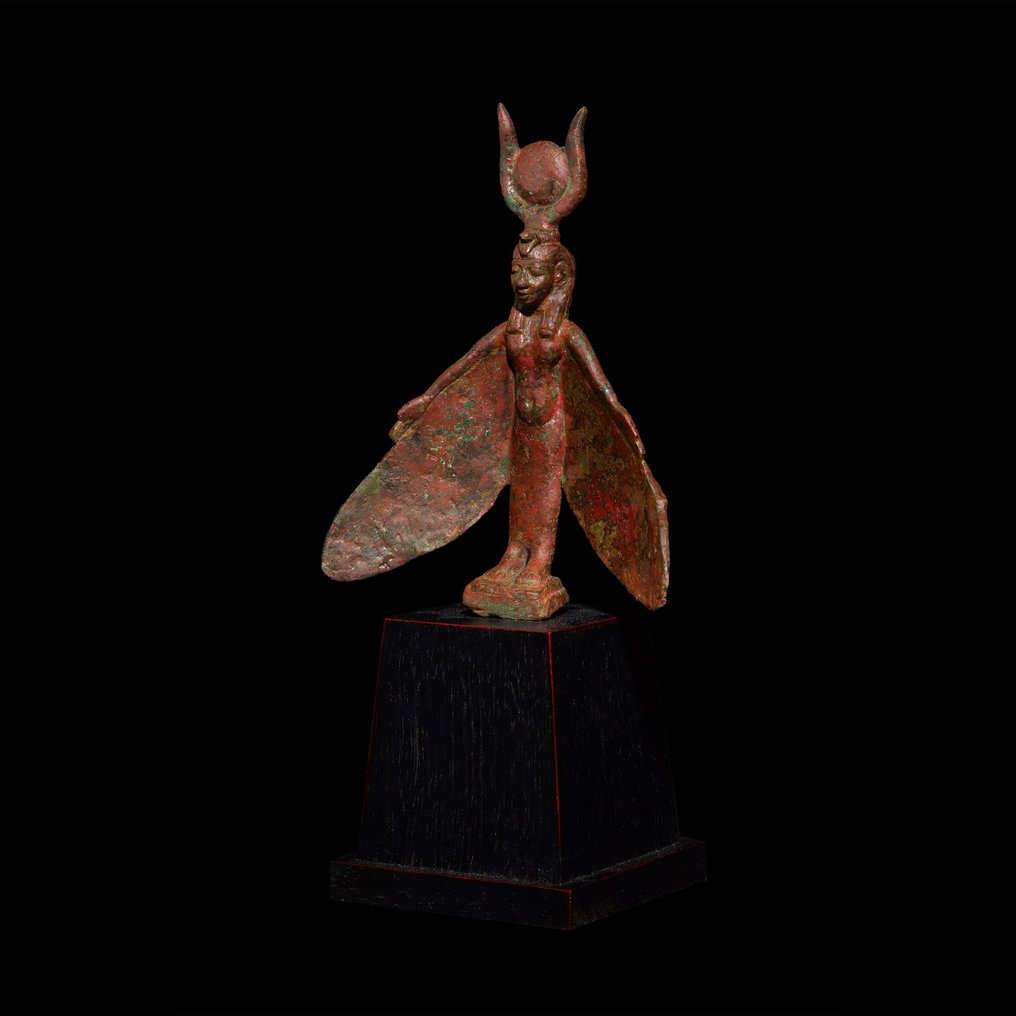
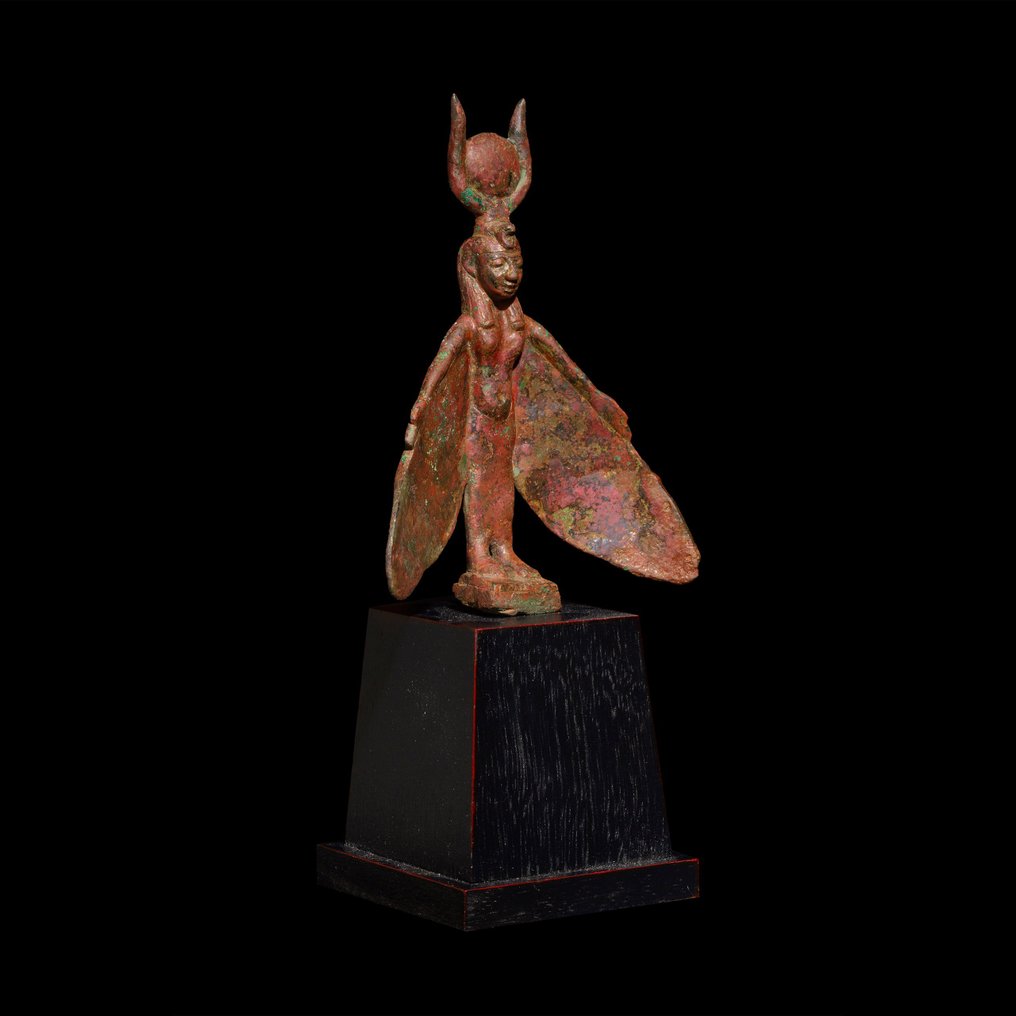
Winged Goddess Isis.
Ancient Egypt, Late Period, 664 - 332 BC
MATERIAL: Bronze.
DIMENSIONS: 13 cm height and 20.5 cm with the stand.
PROVENANCE: Private collection, Louviers, France, 1960 – 1980.
CONDITION: Good condition in general, with restoration on the tip of the crown horns and on the lower part of the right wing.
DESCRIPTION:
A statuette made of bronze by lost wax casting represents the goddess Isis with large falcon wings under her arms, which she extends towards the front in a gesture of protection. The symbolic and magical importance of the wings is reflected in their large size, which also translates into remarkably long arms about the rest of the body. The wings show meticulous work on their external side, based on fine incisions that represent the plumage. The figure appears standing, dressed in a fine tight tunic common in representations of goddesses, which reveals anatomical details such as the profile of the belly, the navel, and the nipples, a feature that is repeated in other similar pieces (fig. 1).
On her head, Isis wears a headdress made up of cow horns that frame a solar disk, with the urea on her forehead. This headdress, which Isis shares with the goddess Hathor starting in the New Kingdom, alludes to her character as the goddess of fertility, as well as her status as the daughter of Ra, the solar god par excellence in Egyptian religion. At the back, on the crown of the head, there is a circular ornament that stands out, engraved, on the parallel strands of the tripartite wig. On the front, this wig appears to cover a large part of the forehead, gathered behind the ears and with the two ends resting on the chest. The face of the goddess is delicate despite the small size of the statuette; rounded in shape, with full cheekbones and a small, half-open mouth, with thick lips, large almond-shaped eyes, and a nose that narrows towards its base.
Compared to the torso, which worked with notable volume and attention to detail, the lower extremities are flat; It is probably because a second character would be placed in front of the figure of Isis, whom the goddess magically protects with her wings. Isis Pterophorus (winged Isis) is the protector of Osiris and is usually represented as seen here, with her wings spread downward, flanking the body of her brother-husband (fig. 2). At a typological level it is a scarce model, based on early texts in which Isis and her sister Nephthys, in the form of long-winged falcons, mourn Osiris and protect his reunified body after its dismemberment. They project the shadow of their wings onto it, which they move to direct the air toward its nose and thus renew its life (fig. 3). It is possible, therefore, that the statuette under study was part of a sculptural group made up of three figures, with winged Nephthys in the same position, facing Isis, and Osiris in the center protected by both. The three figures would be placed on an independent bronze or wooden base.
There are also known examples in which Isis appears with this winged-protective character linked to other deities, such as the bull Apis (fig. 4). This type of statuette with Isis Pterophorus was often part of removable groups (fig. 5), with the different figures attached to the same base using a spike (fig. 6), or placed on the same surface, but with different bases. (fig. 7). In any case, the image of winged Isis had an important funerary function; As the Lady of Magic, she had the power to bring the dead back to life, so her magical protection after death was invoked through all types of images placed in the tombs.
The Egyptian goddess Ast, Isis for the Romans, is a celestial deity whose cult has its origins in the Nile Delta. The myth tells that it was she who searched for and recovered the torn body of her husband Osiris, murdered by their brother. Seth. Isis reconstructed the corpse of Osiris with the help of Anubis and Nephthys, and impregnated with his body conceived Horus, who would later avenge the death of his father. Isis was therefore the main deity of Egyptian funerary rituals, considered a protector of the dead. Known by the epithet of the Great Magician, in addition to recomposing the body of her deceased husband, Isis created by magic the first cobra, whose poison she used to force Ra, the Sun, to reveal her secret name. This gave him enormous power over the sun god, power which he shared with his son Horus to help legitimize his right to the throne of Osiris. This magical feat saw the initiation of a secret cult described by Apuleius in The Golden Ass, key in the development of the cult of Isis outside of Egypt.
BIBLIOGRAPHY:
- BIANCHI, R. S. Les bronzes égyptiens. Gandur Foundation for Art, Till Schaap. 2014.
- BOTHMER, B.W. von. Egyptian Sculpture of the Late Period. 700 B.C. to A.D. 100. The Brooklyn Museum. 1960.
- HART, G. The Routledge Dictionary of Egyptian Gods and Goddesses. Routledge. 2005.
- LESKO, B. The Great Goddesses of Egypt. University of Oklahoma Press. 1999.
-LLOYD, A.B. “The Late Period (664-332 B.C.)”, in The Oxford History of Ancient Egypt. Oxford University Press. 2000.
- QUIRKE, S. The religion of Ancient Egypt. Oberon. 2003.
- SCHÄFER, H.; BAINES, J. Principles of Egyptian Art. Griffith Institute Publications. 1986.
PARALLELS:
Fig. 1 Winged Isis. Egypt, Late Antiquity, ca. 664-332 BC. Bronze, 16.5 cm high. Musée du Louvre, Paris, inv. E 4322.
Fig. 2 Winged Isis protecting Osiris. Egypt, Late Antiquity, ca. 712-332 BC. Bronze. Egyptian Museum of Barcelona, inv. 01 E 97b.
Fig. 3 Breastplate of Tutankhamun with Osiris flanked by winged Isis and Nephthys, in the form of a vulture and a cobra. Thebes, Egypt, New Kingdom, 18th Dynasty, reign of Tutankhamun, ca. 1332-1323 BC. Gold, hard stones and glass. Egyptian Museum, Cairo, inv. JE 61946.
Fig. 4 Winged Isis with the bull Apis and offerer figure. Egypt, Late Antiquity, ca. 526-404 BC. Bronze, 16 cm high. Musée du Louvre, inv. E 5888.
Fig. 5 Winged Isis protecting Osiris, with praying figure. Egypt, Late Antiquity, ca. 664-332 BC. Partly gilded bronze, 20.5 cm high. Musée du Louvre, Paris, inv. E 3722.
Fig. 5 Winged Isis protecting Osiris, with praying figure. Egypt, Late Antiquity, ca. 664-332 BC. Partly gilded bronze, 20.5 cm high. Musée du Louvre, Paris, inv. E 3722.
Fig. 5 Winged Isis protecting Osiris, with praying figure. Egypt, Late Antiquity, ca. 664-332 BC. Partly gilded bronze, 20.5 cm high. Musée du Louvre, Paris, inv. E 3722.
Fig. 5 Winged Isis protecting Osiris, with praying figure. Egypt, Late Antiquity, ca. 664-332 BC. Partly gilded bronze, 20.5 cm high. Musée du Louvre, Paris, inv. E 3722.
Fig. 6 Winged Isis. Egypt, Late Antique, ca. 664-332 BC. Bronze, 39 cm high. Musée du Louvre, Paris, inv. N 3961.
Fig. 7 Winged Isis. Egypt, Late Antique, ca. 664-332 BC. Bronze, 30.7 cm high. Musée du Louvre, Paris, inv. N 3962.
Notes:
- The piece includes authenticity certificate.
- The piece includes Spanish Export License (Passport for European Union) - If the piece is destined outside the European Union a substitution of the export permit should be requested, can take between 1-2 weeks maximum.
- The seller guarantees that he acquired this piece according to all national and international laws related to the ownership of cultural property. Provenance statement seen by Catawiki.
#ExclusiveCabinetofCuriosities
Sælger's Historie
Winged Goddess Isis.
Ancient Egypt, Late Period, 664 - 332 BC
MATERIAL: Bronze.
DIMENSIONS: 13 cm height and 20.5 cm with the stand.
PROVENANCE: Private collection, Louviers, France, 1960 – 1980.
CONDITION: Good condition in general, with restoration on the tip of the crown horns and on the lower part of the right wing.
DESCRIPTION:
A statuette made of bronze by lost wax casting represents the goddess Isis with large falcon wings under her arms, which she extends towards the front in a gesture of protection. The symbolic and magical importance of the wings is reflected in their large size, which also translates into remarkably long arms about the rest of the body. The wings show meticulous work on their external side, based on fine incisions that represent the plumage. The figure appears standing, dressed in a fine tight tunic common in representations of goddesses, which reveals anatomical details such as the profile of the belly, the navel, and the nipples, a feature that is repeated in other similar pieces (fig. 1).
On her head, Isis wears a headdress made up of cow horns that frame a solar disk, with the urea on her forehead. This headdress, which Isis shares with the goddess Hathor starting in the New Kingdom, alludes to her character as the goddess of fertility, as well as her status as the daughter of Ra, the solar god par excellence in Egyptian religion. At the back, on the crown of the head, there is a circular ornament that stands out, engraved, on the parallel strands of the tripartite wig. On the front, this wig appears to cover a large part of the forehead, gathered behind the ears and with the two ends resting on the chest. The face of the goddess is delicate despite the small size of the statuette; rounded in shape, with full cheekbones and a small, half-open mouth, with thick lips, large almond-shaped eyes, and a nose that narrows towards its base.
Compared to the torso, which worked with notable volume and attention to detail, the lower extremities are flat; It is probably because a second character would be placed in front of the figure of Isis, whom the goddess magically protects with her wings. Isis Pterophorus (winged Isis) is the protector of Osiris and is usually represented as seen here, with her wings spread downward, flanking the body of her brother-husband (fig. 2). At a typological level it is a scarce model, based on early texts in which Isis and her sister Nephthys, in the form of long-winged falcons, mourn Osiris and protect his reunified body after its dismemberment. They project the shadow of their wings onto it, which they move to direct the air toward its nose and thus renew its life (fig. 3). It is possible, therefore, that the statuette under study was part of a sculptural group made up of three figures, with winged Nephthys in the same position, facing Isis, and Osiris in the center protected by both. The three figures would be placed on an independent bronze or wooden base.
There are also known examples in which Isis appears with this winged-protective character linked to other deities, such as the bull Apis (fig. 4). This type of statuette with Isis Pterophorus was often part of removable groups (fig. 5), with the different figures attached to the same base using a spike (fig. 6), or placed on the same surface, but with different bases. (fig. 7). In any case, the image of winged Isis had an important funerary function; As the Lady of Magic, she had the power to bring the dead back to life, so her magical protection after death was invoked through all types of images placed in the tombs.
The Egyptian goddess Ast, Isis for the Romans, is a celestial deity whose cult has its origins in the Nile Delta. The myth tells that it was she who searched for and recovered the torn body of her husband Osiris, murdered by their brother. Seth. Isis reconstructed the corpse of Osiris with the help of Anubis and Nephthys, and impregnated with his body conceived Horus, who would later avenge the death of his father. Isis was therefore the main deity of Egyptian funerary rituals, considered a protector of the dead. Known by the epithet of the Great Magician, in addition to recomposing the body of her deceased husband, Isis created by magic the first cobra, whose poison she used to force Ra, the Sun, to reveal her secret name. This gave him enormous power over the sun god, power which he shared with his son Horus to help legitimize his right to the throne of Osiris. This magical feat saw the initiation of a secret cult described by Apuleius in The Golden Ass, key in the development of the cult of Isis outside of Egypt.
BIBLIOGRAPHY:
- BIANCHI, R. S. Les bronzes égyptiens. Gandur Foundation for Art, Till Schaap. 2014.
- BOTHMER, B.W. von. Egyptian Sculpture of the Late Period. 700 B.C. to A.D. 100. The Brooklyn Museum. 1960.
- HART, G. The Routledge Dictionary of Egyptian Gods and Goddesses. Routledge. 2005.
- LESKO, B. The Great Goddesses of Egypt. University of Oklahoma Press. 1999.
-LLOYD, A.B. “The Late Period (664-332 B.C.)”, in The Oxford History of Ancient Egypt. Oxford University Press. 2000.
- QUIRKE, S. The religion of Ancient Egypt. Oberon. 2003.
- SCHÄFER, H.; BAINES, J. Principles of Egyptian Art. Griffith Institute Publications. 1986.
PARALLELS:
Fig. 1 Winged Isis. Egypt, Late Antiquity, ca. 664-332 BC. Bronze, 16.5 cm high. Musée du Louvre, Paris, inv. E 4322.
Fig. 2 Winged Isis protecting Osiris. Egypt, Late Antiquity, ca. 712-332 BC. Bronze. Egyptian Museum of Barcelona, inv. 01 E 97b.
Fig. 3 Breastplate of Tutankhamun with Osiris flanked by winged Isis and Nephthys, in the form of a vulture and a cobra. Thebes, Egypt, New Kingdom, 18th Dynasty, reign of Tutankhamun, ca. 1332-1323 BC. Gold, hard stones and glass. Egyptian Museum, Cairo, inv. JE 61946.
Fig. 4 Winged Isis with the bull Apis and offerer figure. Egypt, Late Antiquity, ca. 526-404 BC. Bronze, 16 cm high. Musée du Louvre, inv. E 5888.
Fig. 5 Winged Isis protecting Osiris, with praying figure. Egypt, Late Antiquity, ca. 664-332 BC. Partly gilded bronze, 20.5 cm high. Musée du Louvre, Paris, inv. E 3722.
Fig. 5 Winged Isis protecting Osiris, with praying figure. Egypt, Late Antiquity, ca. 664-332 BC. Partly gilded bronze, 20.5 cm high. Musée du Louvre, Paris, inv. E 3722.
Fig. 5 Winged Isis protecting Osiris, with praying figure. Egypt, Late Antiquity, ca. 664-332 BC. Partly gilded bronze, 20.5 cm high. Musée du Louvre, Paris, inv. E 3722.
Fig. 5 Winged Isis protecting Osiris, with praying figure. Egypt, Late Antiquity, ca. 664-332 BC. Partly gilded bronze, 20.5 cm high. Musée du Louvre, Paris, inv. E 3722.
Fig. 6 Winged Isis. Egypt, Late Antique, ca. 664-332 BC. Bronze, 39 cm high. Musée du Louvre, Paris, inv. N 3961.
Fig. 7 Winged Isis. Egypt, Late Antique, ca. 664-332 BC. Bronze, 30.7 cm high. Musée du Louvre, Paris, inv. N 3962.
Notes:
- The piece includes authenticity certificate.
- The piece includes Spanish Export License (Passport for European Union) - If the piece is destined outside the European Union a substitution of the export permit should be requested, can take between 1-2 weeks maximum.
- The seller guarantees that he acquired this piece according to all national and international laws related to the ownership of cultural property. Provenance statement seen by Catawiki.
#ExclusiveCabinetofCuriosities
Sælger's Historie
- 818
- 9
- 2
Muy buenos siempre … Bagot siempre es de confianza.
Se oversættelseI am really pleased with my purchase it's really lovely. It's beauty and quality exceed my expectations. The object was well wrapped and packed.
Se oversættelseGisteren niet ontvangen normal hebben ze mijn handtekening nodig doch lag bij de gebeuren ,eind goeg al goed😃😊
Se oversættelsebellissima ciotola etrusca top 💯💯💯💯💯💯💯💯 grazie :-)
Se oversættelseTodo bien
Se oversættelseMuy bien todo. Gracias
Se oversættelsePerfect
Se oversættelseThank you, everything was perfect!
Se oversættelsepiezas muy interesantes. Todo muy correcto, como siempre.
Se oversættelseestoy muy agradecida por como han tenido tanto tacto y cuidado en enviar la figura protegida, su certificado de autenticidad es muy profesional, al igual que su atención y trato con el cliente
Se oversættelseEl vendedor cumple lo prometido, el objeto es de alta calidad, entonces estoy muy satisfecho con mi compra, muchas gracias.
Se oversættelsePerfect!
Se oversættelseI just love the mood in this picture! I’m not even a cat-person. Seller was nice and made sure to ship it on a certain date, since i was traveling. I’m very happy with my purchase 🐱🤩 thank you!
Se oversættelseAll good, thank you !
Se oversættelseAll good, thank you !
Se oversættelseOne item was missing, one was damaged. Photos sent as requested. After that, no more communication even when asked. Too bad!
Se oversættelsemerci, jolie bijou.
Se oversættelseIk heb het goed en snel ontvangen. Het ziet er goed uit. Ben er blij mee.
Se oversættelseGreat seller!!
Se oversættelseBagot siempre rápido y fiable, muchas gracias
Se oversættelsegreat scarab! very fast shipping! thank you very much!
Se oversættelseTodo bien. Vendedor recomendado.
Se oversættelseAbsolut vertrauenswürdiger Händler ! Und: ein ganz zauberhaftes Stück !
Se oversættelseOttimo imballo particolare come da foto
Se oversættelse- 818
- 9
- 2
Ware sicher verpackt und schnell verschickt. Alles bestens!
Se oversættelseDisclaimer
Sælger garanterer og kan bevise, at genstanden er erhvervet på lovlig vis. Sælger er blevet informeret af Catawiki om, at skulle fremskaffe den dokumentation, der kræves af love og regler i dennes bopælsland. Sælger garanterer at være berettiget til, at måtte sælge/eksportere denne genstand. Sælger sørger for, at al information vedrørende proveniensen af en genstand vil blive videregivet til køber. Sælger sørger for, at eventuelle nødvendige tilladelser er blevet eller vil blive indhentet. Sælger vil omgående informere køber om eventuelle forsinkelser i forbindelse med indhentelse af sådanne tilladelser.
Sælger garanterer og kan bevise, at genstanden er erhvervet på lovlig vis. Sælger er blevet informeret af Catawiki om, at skulle fremskaffe den dokumentation, der kræves af love og regler i dennes bopælsland. Sælger garanterer at være berettiget til, at måtte sælge/eksportere denne genstand. Sælger sørger for, at al information vedrørende proveniensen af en genstand vil blive videregivet til køber. Sælger sørger for, at eventuelle nødvendige tilladelser er blevet eller vil blive indhentet. Sælger vil omgående informere køber om eventuelle forsinkelser i forbindelse med indhentelse af sådanne tilladelser.